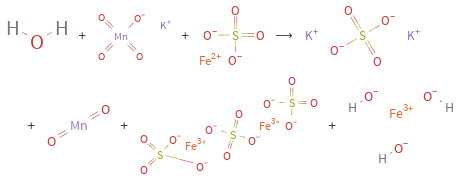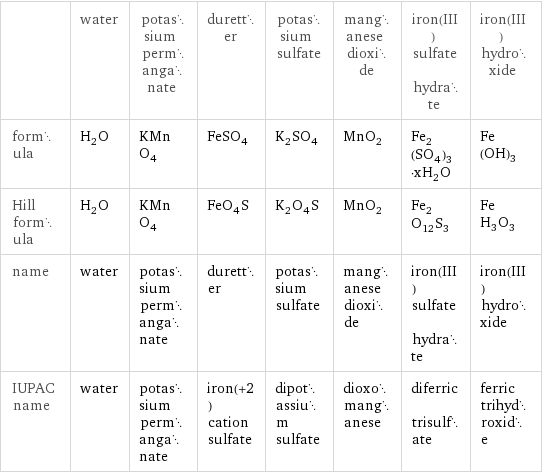Input interpretation

H_2O water + KMnO_4 potassium permanganate + FeSO_4 duretter ⟶ K_2SO_4 potassium sulfate + MnO_2 manganese dioxide + Fe_2(SO_4)_3·xH_2O iron(III) sulfate hydrate + Fe(OH)_3 iron(III) hydroxide
Balanced equation

Balance the chemical equation algebraically: H_2O + KMnO_4 + FeSO_4 ⟶ K_2SO_4 + MnO_2 + Fe_2(SO_4)_3·xH_2O + Fe(OH)_3 Add stoichiometric coefficients, c_i, to the reactants and products: c_1 H_2O + c_2 KMnO_4 + c_3 FeSO_4 ⟶ c_4 K_2SO_4 + c_5 MnO_2 + c_6 Fe_2(SO_4)_3·xH_2O + c_7 Fe(OH)_3 Set the number of atoms in the reactants equal to the number of atoms in the products for H, O, K, Mn, Fe and S: H: | 2 c_1 = 3 c_7 O: | c_1 + 4 c_2 + 4 c_3 = 4 c_4 + 2 c_5 + 12 c_6 + 3 c_7 K: | c_2 = 2 c_4 Mn: | c_2 = c_5 Fe: | c_3 = 2 c_6 + c_7 S: | c_3 = c_4 + 3 c_6 Since the coefficients are relative quantities and underdetermined, choose a coefficient to set arbitrarily. To keep the coefficients small, the arbitrary value is ordinarily one. For instance, set c_4 = 1 and solve the system of equations for the remaining coefficients: c_1 = 4 c_2 = 2 c_3 = 6 c_4 = 1 c_5 = 2 c_6 = 5/3 c_7 = 8/3 Multiply by the least common denominator, 3, to eliminate fractional coefficients: c_1 = 12 c_2 = 6 c_3 = 18 c_4 = 3 c_5 = 6 c_6 = 5 c_7 = 8 Substitute the coefficients into the chemical reaction to obtain the balanced equation: Answer: | | 12 H_2O + 6 KMnO_4 + 18 FeSO_4 ⟶ 3 K_2SO_4 + 6 MnO_2 + 5 Fe_2(SO_4)_3·xH_2O + 8 Fe(OH)_3
Structures

+ + ⟶ + + +
Names

water + potassium permanganate + duretter ⟶ potassium sulfate + manganese dioxide + iron(III) sulfate hydrate + iron(III) hydroxide
Equilibrium constant
![Construct the equilibrium constant, K, expression for: H_2O + KMnO_4 + FeSO_4 ⟶ K_2SO_4 + MnO_2 + Fe_2(SO_4)_3·xH_2O + Fe(OH)_3 Plan: • Balance the chemical equation. • Determine the stoichiometric numbers. • Assemble the activity expression for each chemical species. • Use the activity expressions to build the equilibrium constant expression. Write the balanced chemical equation: 12 H_2O + 6 KMnO_4 + 18 FeSO_4 ⟶ 3 K_2SO_4 + 6 MnO_2 + 5 Fe_2(SO_4)_3·xH_2O + 8 Fe(OH)_3 Assign stoichiometric numbers, ν_i, using the stoichiometric coefficients, c_i, from the balanced chemical equation in the following manner: ν_i = -c_i for reactants and ν_i = c_i for products: chemical species | c_i | ν_i H_2O | 12 | -12 KMnO_4 | 6 | -6 FeSO_4 | 18 | -18 K_2SO_4 | 3 | 3 MnO_2 | 6 | 6 Fe_2(SO_4)_3·xH_2O | 5 | 5 Fe(OH)_3 | 8 | 8 Assemble the activity expressions accounting for the state of matter and ν_i: chemical species | c_i | ν_i | activity expression H_2O | 12 | -12 | ([H2O])^(-12) KMnO_4 | 6 | -6 | ([KMnO4])^(-6) FeSO_4 | 18 | -18 | ([FeSO4])^(-18) K_2SO_4 | 3 | 3 | ([K2SO4])^3 MnO_2 | 6 | 6 | ([MnO2])^6 Fe_2(SO_4)_3·xH_2O | 5 | 5 | ([Fe2(SO4)3·xH2O])^5 Fe(OH)_3 | 8 | 8 | ([Fe(OH)3])^8 The equilibrium constant symbol in the concentration basis is: K_c Mulitply the activity expressions to arrive at the K_c expression: Answer: | | K_c = ([H2O])^(-12) ([KMnO4])^(-6) ([FeSO4])^(-18) ([K2SO4])^3 ([MnO2])^6 ([Fe2(SO4)3·xH2O])^5 ([Fe(OH)3])^8 = (([K2SO4])^3 ([MnO2])^6 ([Fe2(SO4)3·xH2O])^5 ([Fe(OH)3])^8)/(([H2O])^12 ([KMnO4])^6 ([FeSO4])^18)](../image_source/6a8ea86c65a68299a208797bb2969c5e.png)
Construct the equilibrium constant, K, expression for: H_2O + KMnO_4 + FeSO_4 ⟶ K_2SO_4 + MnO_2 + Fe_2(SO_4)_3·xH_2O + Fe(OH)_3 Plan: • Balance the chemical equation. • Determine the stoichiometric numbers. • Assemble the activity expression for each chemical species. • Use the activity expressions to build the equilibrium constant expression. Write the balanced chemical equation: 12 H_2O + 6 KMnO_4 + 18 FeSO_4 ⟶ 3 K_2SO_4 + 6 MnO_2 + 5 Fe_2(SO_4)_3·xH_2O + 8 Fe(OH)_3 Assign stoichiometric numbers, ν_i, using the stoichiometric coefficients, c_i, from the balanced chemical equation in the following manner: ν_i = -c_i for reactants and ν_i = c_i for products: chemical species | c_i | ν_i H_2O | 12 | -12 KMnO_4 | 6 | -6 FeSO_4 | 18 | -18 K_2SO_4 | 3 | 3 MnO_2 | 6 | 6 Fe_2(SO_4)_3·xH_2O | 5 | 5 Fe(OH)_3 | 8 | 8 Assemble the activity expressions accounting for the state of matter and ν_i: chemical species | c_i | ν_i | activity expression H_2O | 12 | -12 | ([H2O])^(-12) KMnO_4 | 6 | -6 | ([KMnO4])^(-6) FeSO_4 | 18 | -18 | ([FeSO4])^(-18) K_2SO_4 | 3 | 3 | ([K2SO4])^3 MnO_2 | 6 | 6 | ([MnO2])^6 Fe_2(SO_4)_3·xH_2O | 5 | 5 | ([Fe2(SO4)3·xH2O])^5 Fe(OH)_3 | 8 | 8 | ([Fe(OH)3])^8 The equilibrium constant symbol in the concentration basis is: K_c Mulitply the activity expressions to arrive at the K_c expression: Answer: | | K_c = ([H2O])^(-12) ([KMnO4])^(-6) ([FeSO4])^(-18) ([K2SO4])^3 ([MnO2])^6 ([Fe2(SO4)3·xH2O])^5 ([Fe(OH)3])^8 = (([K2SO4])^3 ([MnO2])^6 ([Fe2(SO4)3·xH2O])^5 ([Fe(OH)3])^8)/(([H2O])^12 ([KMnO4])^6 ([FeSO4])^18)
Rate of reaction
![Construct the rate of reaction expression for: H_2O + KMnO_4 + FeSO_4 ⟶ K_2SO_4 + MnO_2 + Fe_2(SO_4)_3·xH_2O + Fe(OH)_3 Plan: • Balance the chemical equation. • Determine the stoichiometric numbers. • Assemble the rate term for each chemical species. • Write the rate of reaction expression. Write the balanced chemical equation: 12 H_2O + 6 KMnO_4 + 18 FeSO_4 ⟶ 3 K_2SO_4 + 6 MnO_2 + 5 Fe_2(SO_4)_3·xH_2O + 8 Fe(OH)_3 Assign stoichiometric numbers, ν_i, using the stoichiometric coefficients, c_i, from the balanced chemical equation in the following manner: ν_i = -c_i for reactants and ν_i = c_i for products: chemical species | c_i | ν_i H_2O | 12 | -12 KMnO_4 | 6 | -6 FeSO_4 | 18 | -18 K_2SO_4 | 3 | 3 MnO_2 | 6 | 6 Fe_2(SO_4)_3·xH_2O | 5 | 5 Fe(OH)_3 | 8 | 8 The rate term for each chemical species, B_i, is 1/ν_i(Δ[B_i])/(Δt) where [B_i] is the amount concentration and t is time: chemical species | c_i | ν_i | rate term H_2O | 12 | -12 | -1/12 (Δ[H2O])/(Δt) KMnO_4 | 6 | -6 | -1/6 (Δ[KMnO4])/(Δt) FeSO_4 | 18 | -18 | -1/18 (Δ[FeSO4])/(Δt) K_2SO_4 | 3 | 3 | 1/3 (Δ[K2SO4])/(Δt) MnO_2 | 6 | 6 | 1/6 (Δ[MnO2])/(Δt) Fe_2(SO_4)_3·xH_2O | 5 | 5 | 1/5 (Δ[Fe2(SO4)3·xH2O])/(Δt) Fe(OH)_3 | 8 | 8 | 1/8 (Δ[Fe(OH)3])/(Δt) (for infinitesimal rate of change, replace Δ with d) Set the rate terms equal to each other to arrive at the rate expression: Answer: | | rate = -1/12 (Δ[H2O])/(Δt) = -1/6 (Δ[KMnO4])/(Δt) = -1/18 (Δ[FeSO4])/(Δt) = 1/3 (Δ[K2SO4])/(Δt) = 1/6 (Δ[MnO2])/(Δt) = 1/5 (Δ[Fe2(SO4)3·xH2O])/(Δt) = 1/8 (Δ[Fe(OH)3])/(Δt) (assuming constant volume and no accumulation of intermediates or side products)](../image_source/68dd06e54c4c88231e8b50efa56d5d66.png)
Construct the rate of reaction expression for: H_2O + KMnO_4 + FeSO_4 ⟶ K_2SO_4 + MnO_2 + Fe_2(SO_4)_3·xH_2O + Fe(OH)_3 Plan: • Balance the chemical equation. • Determine the stoichiometric numbers. • Assemble the rate term for each chemical species. • Write the rate of reaction expression. Write the balanced chemical equation: 12 H_2O + 6 KMnO_4 + 18 FeSO_4 ⟶ 3 K_2SO_4 + 6 MnO_2 + 5 Fe_2(SO_4)_3·xH_2O + 8 Fe(OH)_3 Assign stoichiometric numbers, ν_i, using the stoichiometric coefficients, c_i, from the balanced chemical equation in the following manner: ν_i = -c_i for reactants and ν_i = c_i for products: chemical species | c_i | ν_i H_2O | 12 | -12 KMnO_4 | 6 | -6 FeSO_4 | 18 | -18 K_2SO_4 | 3 | 3 MnO_2 | 6 | 6 Fe_2(SO_4)_3·xH_2O | 5 | 5 Fe(OH)_3 | 8 | 8 The rate term for each chemical species, B_i, is 1/ν_i(Δ[B_i])/(Δt) where [B_i] is the amount concentration and t is time: chemical species | c_i | ν_i | rate term H_2O | 12 | -12 | -1/12 (Δ[H2O])/(Δt) KMnO_4 | 6 | -6 | -1/6 (Δ[KMnO4])/(Δt) FeSO_4 | 18 | -18 | -1/18 (Δ[FeSO4])/(Δt) K_2SO_4 | 3 | 3 | 1/3 (Δ[K2SO4])/(Δt) MnO_2 | 6 | 6 | 1/6 (Δ[MnO2])/(Δt) Fe_2(SO_4)_3·xH_2O | 5 | 5 | 1/5 (Δ[Fe2(SO4)3·xH2O])/(Δt) Fe(OH)_3 | 8 | 8 | 1/8 (Δ[Fe(OH)3])/(Δt) (for infinitesimal rate of change, replace Δ with d) Set the rate terms equal to each other to arrive at the rate expression: Answer: | | rate = -1/12 (Δ[H2O])/(Δt) = -1/6 (Δ[KMnO4])/(Δt) = -1/18 (Δ[FeSO4])/(Δt) = 1/3 (Δ[K2SO4])/(Δt) = 1/6 (Δ[MnO2])/(Δt) = 1/5 (Δ[Fe2(SO4)3·xH2O])/(Δt) = 1/8 (Δ[Fe(OH)3])/(Δt) (assuming constant volume and no accumulation of intermediates or side products)
Chemical names and formulas

| water | potassium permanganate | duretter | potassium sulfate | manganese dioxide | iron(III) sulfate hydrate | iron(III) hydroxide formula | H_2O | KMnO_4 | FeSO_4 | K_2SO_4 | MnO_2 | Fe_2(SO_4)_3·xH_2O | Fe(OH)_3 Hill formula | H_2O | KMnO_4 | FeO_4S | K_2O_4S | MnO_2 | Fe_2O_12S_3 | FeH_3O_3 name | water | potassium permanganate | duretter | potassium sulfate | manganese dioxide | iron(III) sulfate hydrate | iron(III) hydroxide IUPAC name | water | potassium permanganate | iron(+2) cation sulfate | dipotassium sulfate | dioxomanganese | diferric trisulfate | ferric trihydroxide